War is a creative catastrophe: It offers its participants so many ways to die. Many military personnel die in combat, of course. But many others die before they ever ship overseas to face the enemy.
 For example, during World War I eleven soldiers training at Camp Bowie were killed when a trench mortar exploded.
For example, during World War I eleven soldiers training at Camp Bowie were killed when a trench mortar exploded.
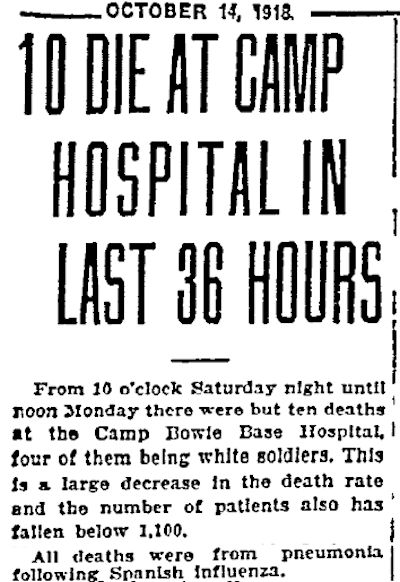 And dozens of soldiers at Camp Bowie died during the influenza pandemic in 1918. (Most deaths during the influenza pandemic were caused by bacterial pneumonia after influenza virus infection.)
And dozens of soldiers at Camp Bowie died during the influenza pandemic in 1918. (Most deaths during the influenza pandemic were caused by bacterial pneumonia after influenza virus infection.)
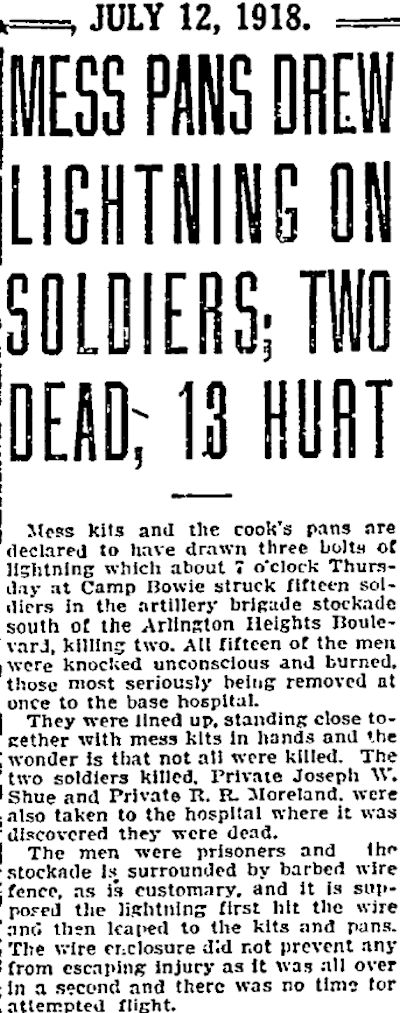 Soldiers could be killed even while just standing in line for chow: Two soldiers in the Camp Bowie artillery brigade stockade were killed when they were struck by lightning. Three bolts of lightning were thought to have struck the barbed wire fence around the stockade and then to have jumped to the metal mess kits the men were holding.
Soldiers could be killed even while just standing in line for chow: Two soldiers in the Camp Bowie artillery brigade stockade were killed when they were struck by lightning. Three bolts of lightning were thought to have struck the barbed wire fence around the stockade and then to have jumped to the metal mess kits the men were holding.
 And at Camp Taliaferro thirty-nine men were killed during the few months that Royal Flying Corps cadets trained at the three airfields. The cadets expected to fight the enemy in Europe. Instead they died on the prairie of north Texas.
And at Camp Taliaferro thirty-nine men were killed during the few months that Royal Flying Corps cadets trained at the three airfields. The cadets expected to fight the enemy in Europe. Instead they died on the prairie of north Texas.
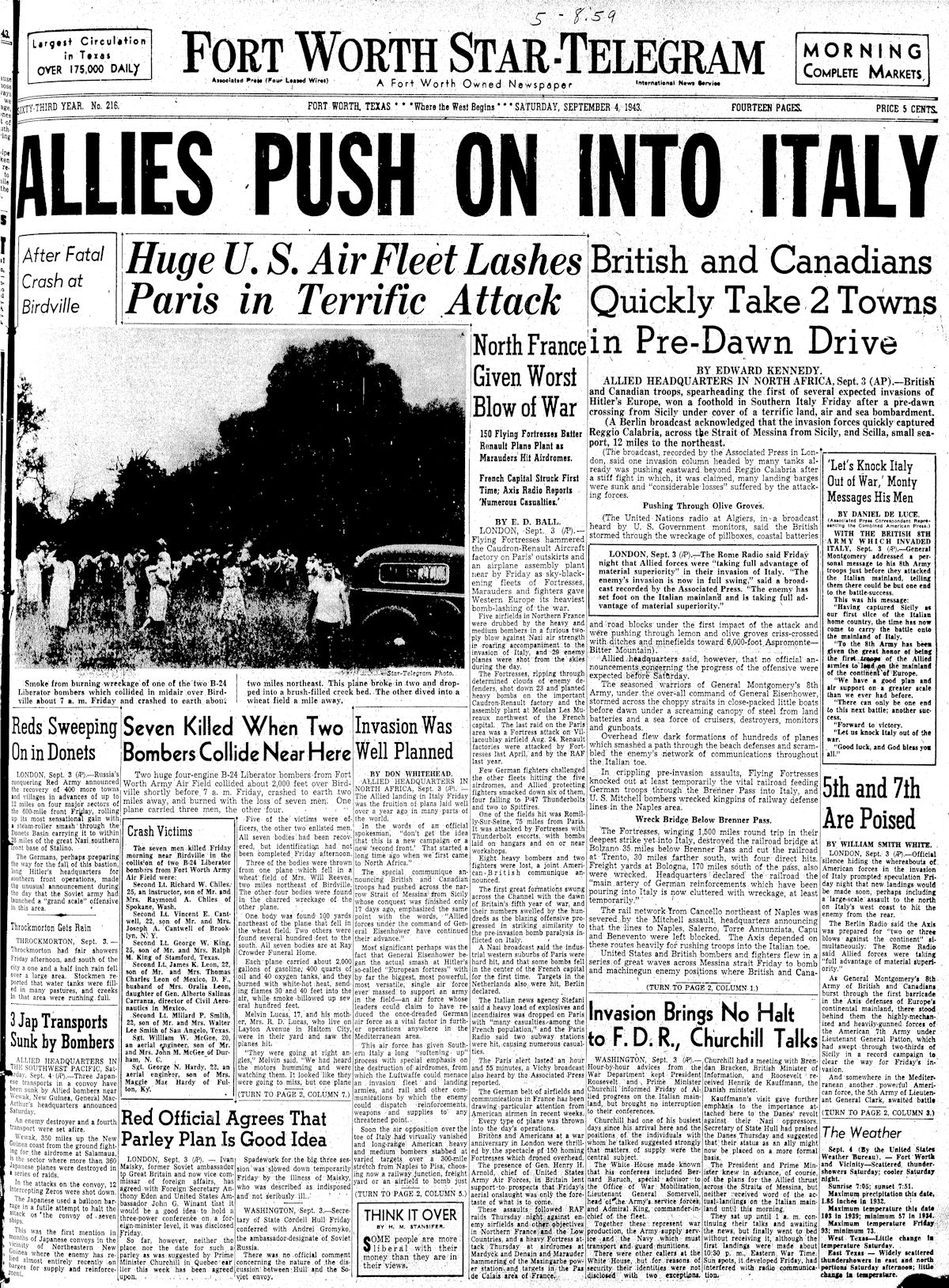 Fast-forward to the next world war. On September 4, 1943 news of World War II dominated the front page of the Star-Telegram.
Fast-forward to the next world war. On September 4, 1943 news of World War II dominated the front page of the Star-Telegram.
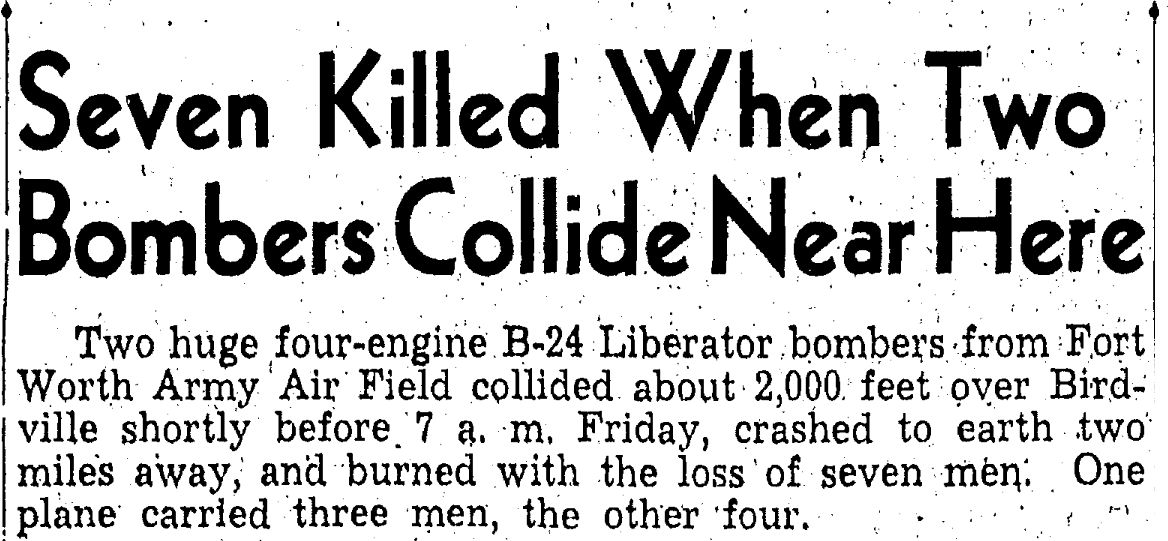 Among the page 1 headlines was this one. About 7 a.m. on September 3 two B-24 Liberator bombers from Fort Worth Army Air Field were flying over Birdville at an altitude of about two thousand feet when they collided at a right angle. One plane broke in two and fell into a brushy creek (possibly Big Fossil Creek). The other plane fell into a wheat field. Both planes burned.
Among the page 1 headlines was this one. About 7 a.m. on September 3 two B-24 Liberator bombers from Fort Worth Army Air Field were flying over Birdville at an altitude of about two thousand feet when they collided at a right angle. One plane broke in two and fell into a brushy creek (possibly Big Fossil Creek). The other plane fell into a wheat field. Both planes burned.
All seven men on the two planes were killed.
The Star-Telegram reported that each B-24 carried two thousand gallons of gasoline, four hundred quarts of oil, and forty oxygen tanks, and “burned with white-hot heat, sending flames 30 and 40 feet into the air, while smoke billowed up several hundred feet.”
J’Nell Pate in her Arsenal of Defense writes that the two planes “fell to the ground about where . . . Richland Plaza Shopping Center was later located on East Belknap just east of the present Birdville Independent School District Administration Complex and football field.”
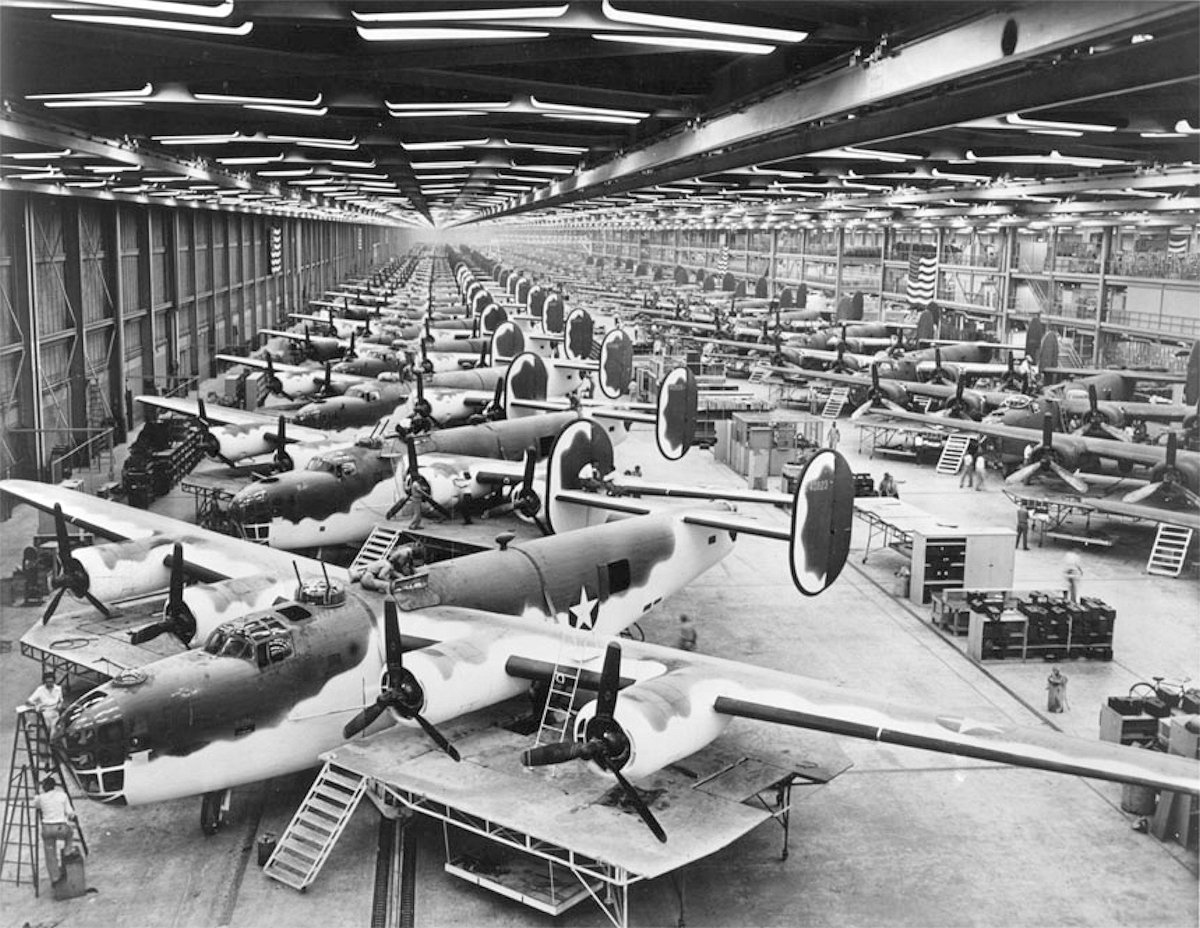 B-24s were built at the bomber plant, and B-24 crews trained next door at Fort Worth Army Air Field (renamed “Carswell Air Force Base” in 1948). (Photo from Wikipedia.)
B-24s were built at the bomber plant, and B-24 crews trained next door at Fort Worth Army Air Field (renamed “Carswell Air Force Base” in 1948). (Photo from Wikipedia.)
Mrs. R. D. Lucas and her son Melvin, seventeen, of Layton Avenue in Haltom City, saw the collision over Birdville.
“They were going at right angles,” Melvin said of the two B-24s. “We heard the motors humming and were watching them. It looked like they were going to miss, but one plane hit the other one back toward the tail and it broke up.”
The Star-Telegram wrote: “Mrs. Lucas said the broken plane fell like a rock and the other one ‘sort of went off in a short glide.’”
Another witness said the two planes were in flames as they fell to the ground.
Several thousand people quickly gathered at the two crash sites. Military police and Navy shore patrol were dispatched to keep bystanders back because of the danger of explosions.

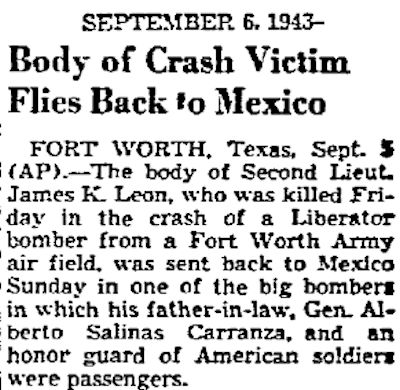 Funerals for the seven men were planned as an investigation into the cause of the collision was begun. (I can find no newspaper reports about the findings of that investigation. No newspaper report mentions visibility as a factor in the collision.) Second Lieutenant James K. Leon, a native of Mexico and the son-in-law of General Alberto Salinas Carranza, Mexico’s director of civil aeronautics, had been married only one month. His body was flown back to Mexico accompanied by an honor guard.
Funerals for the seven men were planned as an investigation into the cause of the collision was begun. (I can find no newspaper reports about the findings of that investigation. No newspaper report mentions visibility as a factor in the collision.) Second Lieutenant James K. Leon, a native of Mexico and the son-in-law of General Alberto Salinas Carranza, Mexico’s director of civil aeronautics, had been married only one month. His body was flown back to Mexico accompanied by an honor guard.
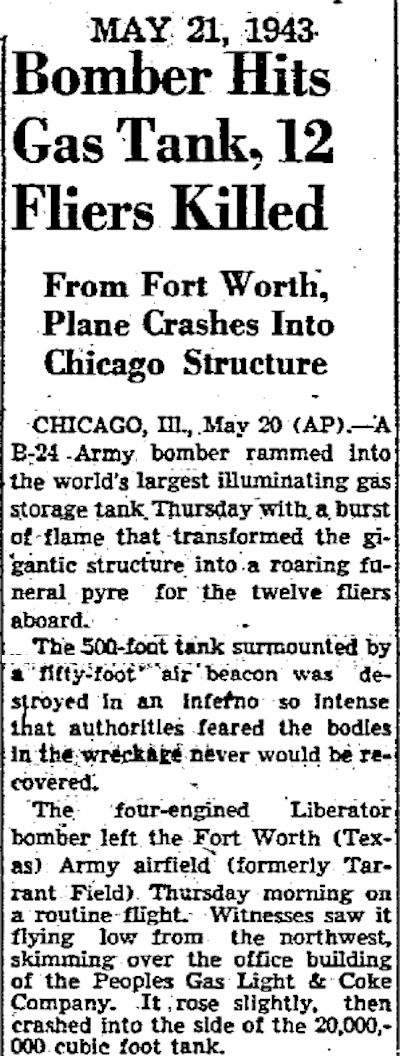 The fatal accident over Birdville was only the second of the war for men training at Fort Worth Army Air Field. On May 20, 1943 a B-24 of the 1014th Pilot Transition Training Squadron was approaching its designated airport near Chicago. The crew was flying in light rain, light fog, and light smoke with a five-hundred-foot ceiling and less than one mile visibility. Only 125 feet off the ground the B-24 smashed into a five-hundred-foot-tall gasoline storage tank. The airplane and the storage tank burst into flame, throwing white-hot sheet metal one mile. All twelve men on board were killed.
The fatal accident over Birdville was only the second of the war for men training at Fort Worth Army Air Field. On May 20, 1943 a B-24 of the 1014th Pilot Transition Training Squadron was approaching its designated airport near Chicago. The crew was flying in light rain, light fog, and light smoke with a five-hundred-foot ceiling and less than one mile visibility. Only 125 feet off the ground the B-24 smashed into a five-hundred-foot-tall gasoline storage tank. The airplane and the storage tank burst into flame, throwing white-hot sheet metal one mile. All twelve men on board were killed.
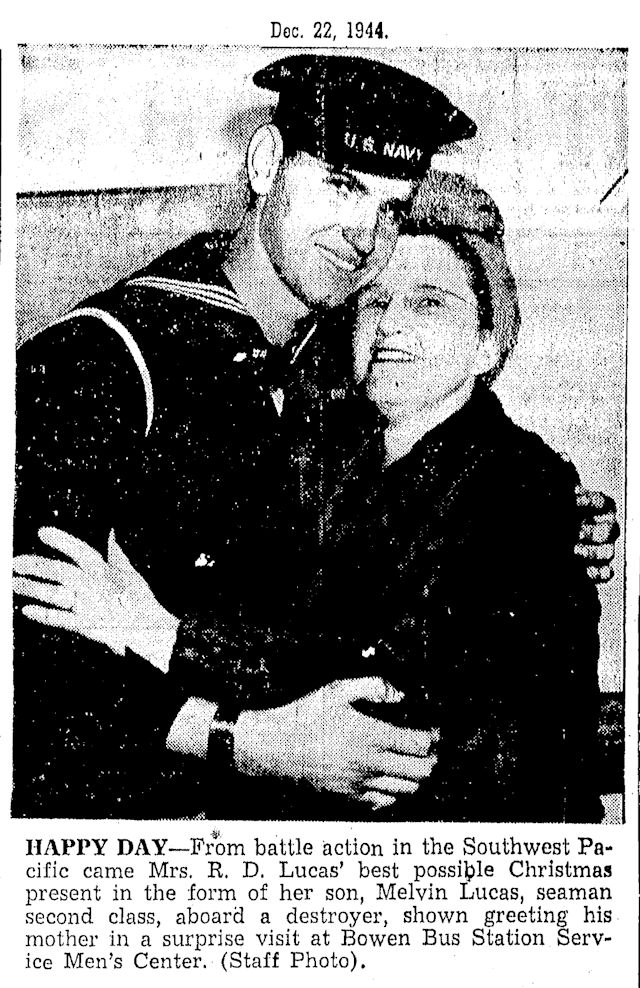 As for Birdville eyewitness Melvin Lucas, eight months after the collision he enlisted in the military at age eighteen. Perhaps he had been affected by what he had seen over Birdville in 1943: When he enlisted he had chosen to go to sea, not into the wild blue yonder. In December 1944 he came home to spend Christmas with his mother after serving seven months on a destroyer in the Pacific Ocean. (The Bowen bus station was on Main Street at Lancaster Avenue.)
As for Birdville eyewitness Melvin Lucas, eight months after the collision he enlisted in the military at age eighteen. Perhaps he had been affected by what he had seen over Birdville in 1943: When he enlisted he had chosen to go to sea, not into the wild blue yonder. In December 1944 he came home to spend Christmas with his mother after serving seven months on a destroyer in the Pacific Ocean. (The Bowen bus station was on Main Street at Lancaster Avenue.)
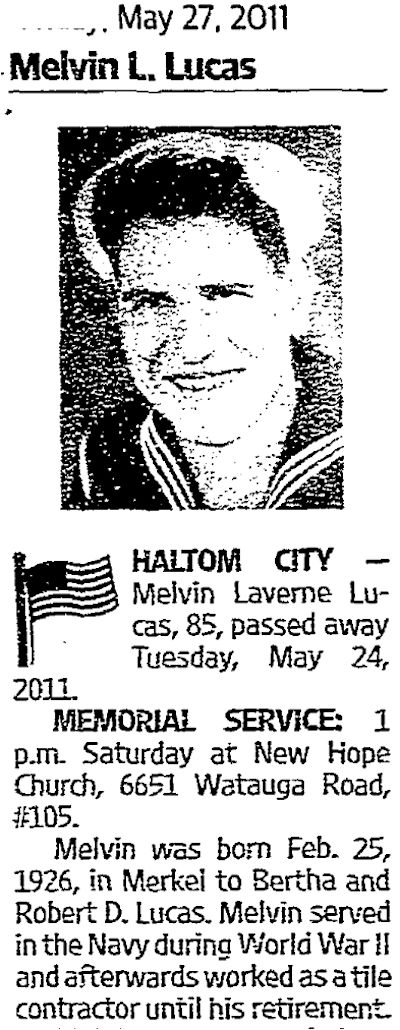 But wait! Can we not find some soothing exception to this death toll of young men? Yes. Melvin Lucas not only went to war in 1944 but also survived it and returned to Haltom City to live the long life that had been denied to the young men who had died during training. Lucas died in 2011, at age eighty-five, at his home just one street over from where he and his mother had watched the two B-24s collide in 1943.
But wait! Can we not find some soothing exception to this death toll of young men? Yes. Melvin Lucas not only went to war in 1944 but also survived it and returned to Haltom City to live the long life that had been denied to the young men who had died during training. Lucas died in 2011, at age eighty-five, at his home just one street over from where he and his mother had watched the two B-24s collide in 1943.





